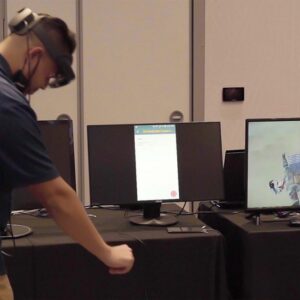Accelint is creating more realistic combat casualty care training with augmented reality innovations for warfighter simulations under a Small Business Innovation Research (SBIR) contract with the Program Executive Office Simulation Training and Instrumentation.
Saving warfighter lives on the battlefield is critical. But for all military services, simulated medical training is extremely complex and difficult.
“Realistic wound behavior, as well as physical and psychological reactions to trauma and treatment, are difficult to simulate for trainees,” said Dr. Alyssa Tanaka, scientist at Accelint.
Wounds are often created using simple moulage that may look realistic at the start, but it does not change over the course of treatment. Casualties may be simulated by medical mannequins or human role-players and cannot exhibit the very physical or psychological condition associated with an injury. Adding to this challenge, instructors are overburdened with directing and producing an elaborate and unrealistic simulation rather than dedicating their focus to trainee education and evaluation.
With Combat Casualty Care Augmented Reality Intelligent Training Systems (C3ARESYS), trainees use Microsoft HoloLens 2 goggles to view virtual injuries overlaid on a simulated casualty whose physiology and psychology matches that of someone with the selected injury, and changes based on the treatment provided by the trainee.

This AR-based technology allows trainees to immediately and more realistically gage the response of their diagnosis and treatments, while giving instructors more freedom to monitor student performance. C3ARESYS is also integrated with Accelint’s speech understanding capabilities, allowing the student to verbally interact with the synthetic patient.
Trainees use Microsoft HoloLens 2 goggles to view virtual injuries overlaid on a simulated casualty whose physiology and psychology matches that of someone with the selected injury, As C3ARESYS evolves, the solution could have real-world, real-time applications.
“Beyond uses for training, C3ARESYS may one day be used on the battlefield to help treat wounded service members,” explained Tanaka. “When the medic is injured or a wounded soldier cannot be evacuated in a timely way, C3ARESYS will be able to instruct even an untrained servicemember to assess, treat and stabilize patients over a long period.”
“For the civilian population,” Tanaka continued, “the system could help first responders care for patients in a complex way before the patient is able to access advanced care.”
